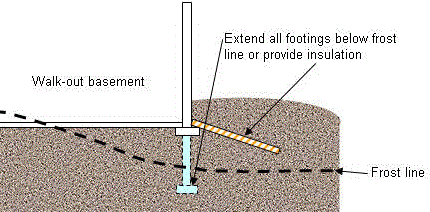

- #Placing footing per frost depth full#
- #Placing footing per frost depth code#
- #Placing footing per frost depth crack#
will be plenty for 8-inch-thick footings up to 4 feet wide. In most residential situations, #4 rod at 12 inches o.c. Instead, however, you could rein-force the footing with transverse steel (running in the crosswise direction, not along the footing). So, for example, a 32-inch-wide footing under an 8-inch wall would need to be at least 12 inches thick. The projection of the footing on either side of the wall is supposed to be no greater than the depth of the footing.
#Placing footing per frost depth crack#
That’s because a footing that’s too wide and not thick enough will experience a bending force that could crack the concrete.
#Placing footing per frost depth code#
If you increase the footing width, the code requires an increased thickness as well. Without reinforcement, codes say the thickness of the footing should be at least as great as the distance it projects next to the wall. An unreinforced footing that is too wide may crack close to the wall, overloading the soil beneath. (in reference to footings under framed walls)… ” When a footing must be widened to boost bearing ability, it should also be reinforced or deepened. Now if this was a stick framed building, a nominal eight inch wide concrete foundation wall will support a two story structure, with a 16 inch wide by eight inch thick continuous footing below.įrom …. As in the case of strip footings, when a column base is very wide, a reduction in thickness may be effected by reinforcing the concrete.” For those of us who have forgotten everything we were ever taught about the metric system, this would be a minimum of 5.9 inches thick. It should in no case be less than 150mm thick. They are made not less than 1 1/2 times the projection of the slab beyond the face of the pier or column or the edge of the baseplate of a steel column.

Its shape is usually square and its thickness is governed by the same considerations as for foundation footings. The area of footing is determined by dividing the column load by the safe bearing capacity of the soil.
#Placing footing per frost depth full#
In the case of the engineers for Hansen Buildings, they are using a design with a full eight inches of concrete under each column – over 45% thicker than would be the common industry standard.īut – is this actually adequate? Good question, so I started doing the Google thing.įrom … ”This footing type involves pouring a pad or “cookie” footing at least 12” thick at the bottom of your hole below the frost line.” No basis, in their website, for where this thickness came from.įao.org (Food and Agriculture Organization of the United Nations) … “ Isolated piers or columns are normally carried on independent concrete footings sometimes called pad foundations with the pier or column bearing on the centre point of the footing. Personally, I have never heard a report of a column supporting a post frame building having “punched” through the footing beneath it.

Many individual Building Departments provide handouts for non-engineered post frame buildings, none of which I have ever seen as providing for a footing of greater than six inches of thickness. Throughout the industry, a nominal six inch thickness of concrete (actual thickness is 5-1/2 inches) poured beneath columns is pretty well accepted as being adequate. It seems Alan’s client had engaged a local engineer to do the site design and she had put some ideas in client’s mind of our footings being inadequate.ġ5,000 buildings – I suppose I was due for the first client to question this one! Recently, Alan had a client question the thickness of the concrete footings, beneath the columns, used to support the pressure preservative treated columns. If I had to estimate, I’d venture Alan constructed well over 200 of our buildings. Alan was a post frame building contractor for years, prior to becoming a Building Designer for Hansen Pole Buildings.


 0 kommentar(er)
0 kommentar(er)
